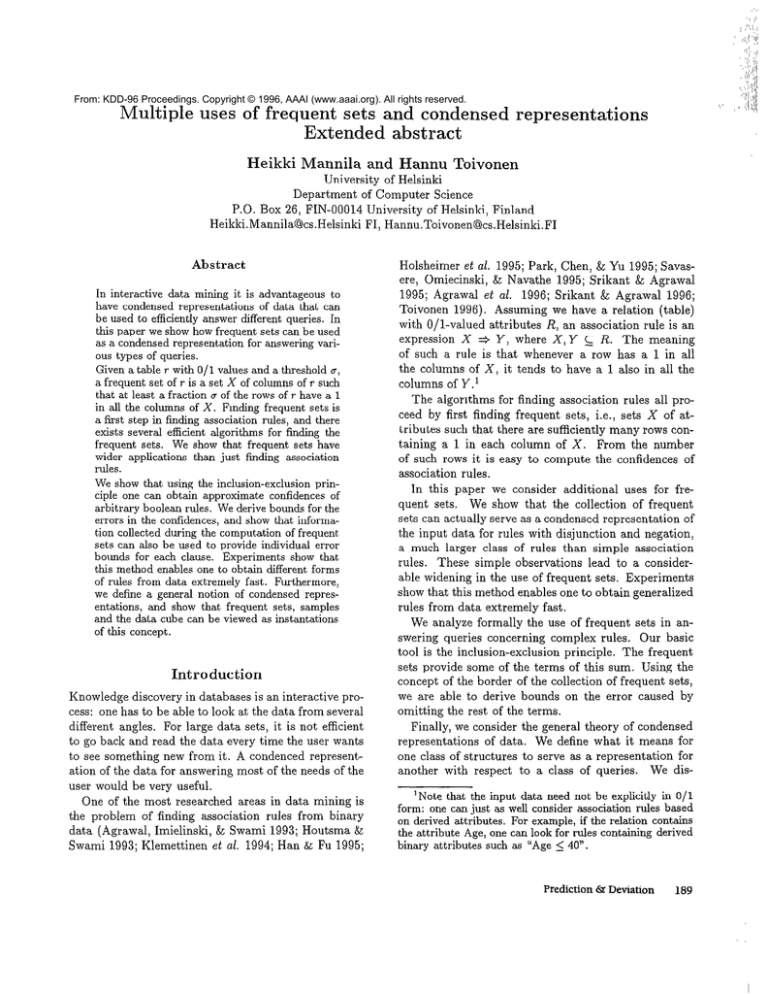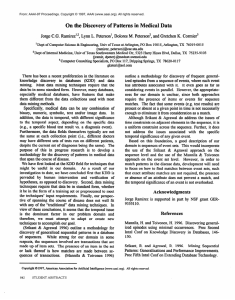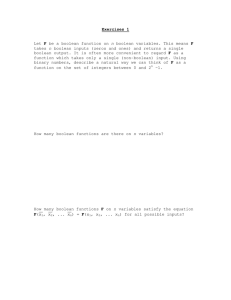
From: KDD-96 Proceedings. Copyright © 1996, AAAI (www.aaai.org). All rights reserved.
Multiple
uses of frequent sets and condensed
Extended abstract
Heikki
Mannila
and Hannu
representations
Toivonen
University of Helsinki
Department of Computer Science
P.O. Box 26, FIN-00014 Universit,y of Helsinki, Finland
Heikki.Mannila@cs.Helsinki
FI, Hannu.Toivonen@cs.Helsinki.FI
Abstract
In interactive data mining it is advantageous to
have condensed representations of data that can
be used to efficiently answer different queries. In
this paper we show how frequent sets can be used
as a condensed representation for answering various types of queries.
6,
Given a table r with O/i vaiues and a threshoid
a frequent set of r is a set X of columns of r such
that at least a fraction u of the rows of r have a 1
in all the columns of X. Finding frequent sets is
a first step in finding association rules, and there
exists several efficient algorithms for &ding the
frequent sets. We show that frequent sets have
wider applications than just finding association
rules.
We show that using the inclusion-exclusion
principle one can obtain approximate confidences of
arbitrary boolean rules. We derive bounds for the
errors in the confidences, and show that information collected during the computation of frequent,
sets can also be used to provide individual error
bounds for each clause. Experiments show that
this method enables one to obtain different forms
-c-..I-_
3-L. exu-errmy
-..I.---,-.
r--l.
UI
~ue8 c---1r0m ua~a
lab. T\.-rl-------~rur~nermore,
we define a general notion of condensed representations, and show that frequent sets, samples
and the data cube can be viewed as instantations
of this concept.
Intro
duction
Knowledge discovery in databases is an interactive process: one has to be able to look at the data from several
different angles, For large data sets, it is not efficient
to go back and read the data every time the user wants
to see something new from it. A condenced representation of the data for answering most of the needs of the
user would be very useful.
One of the most researched areas in data mining is
the problem of finding association rules from binary
data (Agrawal, Imielinski, & Swami 1993; Houtsma &
Swami 1993; Klemettinen et al. 1994; Han &L Fu 1995;
Holsheimer et al. 1995; Park, Chen, & Yu 1995; Savasere, Omiecinski, & Navathe 1995; Srikant & Agrawal
1995; Agrawal et al. 1996; Srikant & Agrawal 1996;
Toivonen 1996). Assuming we have a relation (table)
with O/l-valued attributes R, an association rule is an
expression X + Y, where X, Y C R. The meaning
of such a rule is that whenever a row has a 1 in all
the columns of X, it tends to have a i aiso in all the
columns of Y. l
The algorithms for finding association rules all proceed by first finding frequent sets, i.e., sets X of attributes such that there are sufficiently many rows containing a 1 in each column of X. From the number
of such rows it is easy to compute the confidences of
association rules.
In this paper we consider additional uses for frequent set,s. We show that the collection of frequent
sets can actually serve as a condensed representation of
the input data for rules with disjunction and negation,
a much
rules.
larger
class of rules
than
simple
association
These simple observations lead to a consider-
able widenine
x-d--1 sets: Fxneriments
.----~~cI in
--- the
.--- use of frenuent
-Jml-- __..- 4_..-
show that this method enables one to obtain generalized
rules from data extremely fast.
We analyze formally the use of frequent sets in answering queries concerning complex rules. Our basic
tool is the inclusion-exclusion principle. The frequent
sets provide some of the terms of this sum. Using the
concept of the border of the collection of frequent sets,
we are able to derive bounds on the error caused by
omitting the rest of the terms.
Finally, we consider the general theory of condensed
representations of data. We define what it means for
one class of structures to serve as a representation for
another
with
respect
to a class of queries.
We dis-
‘Note that the input data need not be explicitly in O/l
form: one can just as well consider association rules based
on derived attributes. For example, if the relation contains
the attribute Age, one can look for rules containing derived
binary attributes such as “Age 5 40”.
Prediction & Deviation
189
cuss how the use of frequent sets, samples and the data
cube (Gray et al. 1996) can be viewed as instances
of this general concept. Our concept can be viewed
as a generalization of the notion of &-approximations
from computational geometry (Haussler & Welzl 1987;
Mulmuley 1993).
General
rules
and frequent
sets
Similarly, we can write a rule with a dzsjunctive leftThe rule states that if a row
t E r has a 1 in each column of X or in each column of
Y, then it has a 1 in each column of 2. The confidence
of the rule is
a(XUZ)+a(YUZ)-a(XUYUZ)
a(X)
+ a(Y) - a(X
cl
is, knowing the special terms a(X, T) is suffidetermine the number of rows satisfying any
formula, and hence also the confidence of any
rule.
Example 2 We give some examples of boolean rules
and how their confidences can be expressed in terms of
nf ““‘A,)
mninnrtinnc
“I
U1AU”I”II”.
An assoczatzon rule has the form X +- Y, where
X, Y C R, and the confidence is defined to be a(X U
190
KDD-96
’
side, as
r has a
in each
2. The
a(X U 2) - a(X U Y U 2)
- a(X u Y)
Negatzon an the rpght-hand
.
side is just as easy. The
rnnfirlmr~
K +w.,IAA&uIAAv” nf
-* -FI nlle
&..-” nf
..& f.hr=
“AL- fnrm
~..~,.~. -&
T/
A
7 .iQ
* ,,-ld
a(XUY)-a(XUYUZ)
4X)
Example 3 One of our example data sets T is an enrollment database of courses in computer science. The
data set consists of registration information of 4734
students. There is a row per student, containing the
courses the student has registered for. On average,
a row has 4 courses. The total number of courses
is 127. We first discovered all sets X of courses with
a(X, r) 2 0.05. The number of frequent sets is 489. We
then computed association rules, rules with disjunctions (two disjuncts) on the left or on the right-hand
side, and rules with negations, and then used some
simple selection tools to locate interesting rules from
these sets.
While already association rules produce lots of interesting and sometimes even surprising information
about the data set, looking for more complex rules
makes it possible to locate more subtle phenomena. For
example, we can notice that the confidences of many
rules of the form
X j
C programming V C and Unix
have significantly
vidual rules
higher confidences than the indi-
Y)/aW).
A rule with disjunctrue rzght-hand sade has the form
X + Y V 2 and expresses that if a row t E r has a 1 in
U Y)
Rules can also have negation in the left-hand
in X A 1Y + 2. This means that if a row t E
1 in each column of X and does not have a 1
column of Y, then it has a 1 in each column of
confidence of such a rule is
a(X)
Proposition
1 For all .boolean formulae ‘p over R
there exists sets Wi, . . . , W,
2 R, and coefficients
E (-1, +l} such that for all relations T
el,...,e,
the
UllY fm=nllcnAcx
L’uyu”‘.A”‘v”
4-9
’
i.e., the fraction of rows where ‘p holds.
We introduce some shorthand notations for having
aii or at least one attribute of a set X equal to i: For
we denote a(X,r) = s(Al = 1 A
X = {A1,...,Ak}
. . . A & = 1) and o(X, r) = s(Al = 1 V . . . V Ak = 1);
we simply use notations a(X) and o(X) if the relation
is clear from the context.
A boolean rule over R is an expression of the form
‘p + $, where ‘p and II, are boolean formulae. The
confidence of the rule is s(cp A $)/S(P).
The following proposition is of course well-known.
That
cient, to
boolean
boolean
a(XUY)+a(XUZ)-a(XUYUZ)
hand szde: X V Y + 2.
In this section we describe a simple and basically wellknown rule formalism of general boolean rules, show
that knowledge of the frequencies of sets is sufficient to
determine rule confidences, and give some examples.
Given a set R of O/l-valued attributes R, a boolean
formula over R is a formula ‘p built from the atomic
formulae A = 0 and A = 1, where A E R, using the
connectives A, V, and 1, and parent(hesis. Given a O/l
relation T with attributes R, the frequency s(p, T) of ‘p
in r is
I{t E r 1 ‘p is true of t}l
14
each column of X, then it has a 1 in each column of Y
or in each column of 2. The confidence of the rule is
X *
X +
C programmang
C and Unix.
qxr) I w c R) and
the disjunctzve queries Qv =
:r*o(W,r)jW~R}.
U&V
An e-adequate representataon for S with respect to
e is a class R = {ri ( i E I} of structures and a query
evaluation function m : &J x R + [0, I] such that for all
Q E & and .saE S we have
IQ(%) - m(Q, Till 5 E.
That is, the values of queries from g on any structure
from S can be evaluated using the corresponding representation from R and the query evaluation function
m.
Example 10 Consider as the class of structures S~,si
the class of all O/l relations over the set of attributes
R. Consider the query class Qr, = {Qw ] W 2 R},
where for s E S~,sl we have Qw(s) = u(W,s), i.e.,
the fraction of rows of s such that the row has a 1
in each column of W. Then the collection { Fr(s, E) I
s E S~,ei} of the frequent sets of s, for each s E S~,si,
provides an &-adequate representation of S~,si with respect to &*.
For the telecommunications alarm database we have
n
nnni-,A,,-...,t,
ronrooontot;nn
a “.“““r-au~yucb”b
rb~r~uxzllu~ur”rr th,t
“IIcb”,,,,;,t,
l.“IIUIU”U -irr
“ll,J nf“I
128 sets. In the case of our course enrollment database r the size of a 0.05-adequate representation is
(Fr(r, 0.05) ( = 489 sets. Note that the number of frequent sets does not depend on the number of rows in
0
the database.
The notion of an s-adequate representation is very
closely related to the concept of E-approximations
and s-nets widely used in computational geometry
(Haussler & Welzl 1987; Mulmuley 1993). Roughly,
given a set N and a collection S of subsets of N, an
s-approximation is a subset M C N such that for each
X E S we have
lIxw
IMI
IXII <E
INI - ’
Thus an s-approximation is a subset that gives a good
estimate of the sizes of all subsets in S. The s-adequate
representations differ in two respects: the representation does not have to be of the same form as the original data, and we have additionally required that such
representations exist for every structure in a class of
structures. Still, the results on s-approximations help
in obtaining results about adequate representations.
The existence result for s-approximations was proved
by Vapnik and Chervonenkis, and the sizes of such
approximations are naturally connected with the VCdimension (Vapnik 1982) One can show that samples
provide an s-adequate representation for finite query
classes.
The data cube (Gray et al. 1996) is a recently intraduced summarizing representation for relations with
arbitrary values. Using the concepts above, the data
cube is O-adequate representation for the class of queries containing all aggregate functions. An interesting
possibility is to diminish the space and time complexity
of the data cube by allowing some error. It seems that
this can be accomplished by using a similar strategy as
in the computation of frequent sets,
The preceding discussion of adequate representations
is quite tentative: the usefulness of the notion has yet to
be conclusive demonstrated. It seems to us, however,
that this concept could serve as a unifying point of view
to look at several different types of approximat,e ways
of representing information.
Conclusions
We have shown how the collection of frequent sets can
be used as a condensed representation for a relation
with O/l values. The collection makes it possible to
approximate the confidences of arbitrary boolean rules.
We have given a strong theorem about the sizes of errors caused by the approximation using the concept
of the border of the frequent sets, and have given experimental evidence that the bound is typically extremely good. We h ave also outlined a possible approach to a general theory of condensed representations
and showed how frequent sets, sampling, and also the
data cube can be viewed as instances of this concept.
There are several open questions. On the theoretical
side, the development of the general notions of condensed representation seems useful. From the practical
point of view, a more thorough investigation on t,he actual sizes of the errors in the approximations could be
worthwhile.
References
Agrawal, R.; Mannila, H.; Srikant, R.; Toivonen, H.;
and Verkamo, A. I. 1996. Fast discovery of association rules. In Fayyad, U. M.; Piatetsky-Shapiro, G.;
Smyth, P.; and Uthurusamy, R., eds., Advances zn
Knowledge Discovery and Data Maning. Menlo Park,
CA: AAAI Press. 307 - 328.
Agrawal, R.; Imielinski, T.; and Swami, A. 1993.
Mining association rules between sets of items in large
databases. In Proceedings of A CM SIGMOD
Confer---- on
^- lYll.LIluycllLeY“
n.F--------A
-5 UULcf
n-r- (51uln”u
/orrrnrnnrncJ,l
erlcc
“J
SJ,, 207 _
216.
Grable, D. A. 1993. Sharpened bonferroni inequalities. Journal on Combznatoraal Theory, Seraes B
57(1):131- 137.
Prediction Q Deviation
193
Grable, D. A. 1994. Hypergraphs and sharpened sieve
inequalities. Discrete Mathematacs 132:75 - 82.
Gray, J.; Bosworth, A.; Layman, A.; and Pirahesh, H.
1996. Data Cube: A relational aggregation operator
generalizing group-by, cross-tab, and sub-totals. In
12th International
Conference on Data Engineering
(ICDE’96),
152 - 159.
Han, J., and Fu, Y. 1995. Discovery of multiple-level
association rules from large databases. In Proceedtngs
of the 21st International
Conference on Very Large
Data Bases (VLDB’95),
420 - 431.
Haussler, D., and Welzl, E. 1987. Epsilon-nets
and simplex range queries. Discrete Comput. Geom.
2:127-151.
Holsheimer, M.; Kersten, M.; Mannila, H.; and
Toivonen, H. 1995. A perspective on databases and
data mining. In Proceedings of the First International
Conference on Knowledge Discovery and Data Mining (KDD’95),
150 - 155.
Houtsma, M., and Swami, A. 1993. Set-oriented mining of association rules. Research Report RJ 9567,
TRM ‘Almarlm
R~a~~xv-h Clmt.m
v”.l”vl,
IYA,A
L~~LICVUVIII.,YY”U1Yl~
Kahn, J.; Linial,
N.;
1995. Inclusion-exclusion:
Manuscript.
San ”.lnw
vwA.
.,““,
Cnlifmnia
vyIAA-A -*>.,,.
and Samorodnitsky,
A.
exact and approximate.
Klemettinen,
M.; Mannila, H.; Ronkainen, P.;
Toivonen, H.; and Verkamo, A. I. 1994. Finding interesting rules from large sets of discovered association
Conrules. In Proceedings of the Third International
ference on Information
and Knowledge lkfanagement
(CIKM’94),
401 - 407. Gaithersburg, MD: ACM.
1990.
Approximate
Linial, N., and Nisan, N.
inclusion-exclusion. Combznatorica 10(4):349 - 365.
Mannila, H., and Toivonen, H. 1996. On an algorithm
for finding all interesting sentences. In Cybernetzcs
and Systems,
Volume II, The Thirteenth European
Meeting on Cybernetics and Systems Research, 973 978.
Mulmuley, K. 1993. Computational
Geometry:
An
Introductaon Through Randomazed Algorithms.
New
York: Prentice Hall.
Park, J. S.; Chen, M.-S.; and Yu, P. S. 1995. An
effective hash-based algorithm for mining association
rules. In Proceedings of ACM SIGMOD
Conference
on Management of Data (SIGMOD’95,):
175 - 186.
Savasere, A.; Omiecinski, E.; and Navathe, S. 1995.
An efficient algorithm for mining association rules
in large databases. In Proceedangs of the 21st International Conference on Very Large Data Bases
(VLDB’95),
194
432 - 444.
KDD-96
Srikant, R., and Agrawal, R. 1995. Mining generalized association rules. In Proceedings of the 2lst
Internataonal
Conference on Very Large Data Bases
(VLDB’95),
407 - 419.
Srikant, R., and Agrawal, R. 1996. Mining quantitative association rules in large relational tables. In
Conference on ManProceedangs of ACM SIGMOD
agement of Data (SIGMOD’96).
Toivonen, H. 1996. Sampling large databases for
finding association rules. In Proceedings of the 22nd
International
Conference on Very Large Data Bases
(VLDB’96). To appear.
Vapnik, V. 1982. Estimation
of Dependencaes Based
on Emparacal Data. New York: Springer-Verlag.





